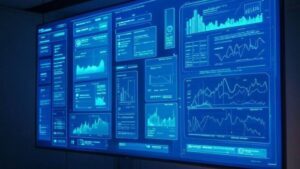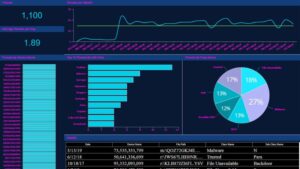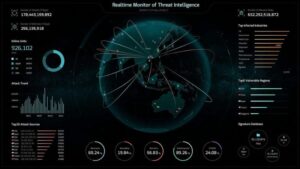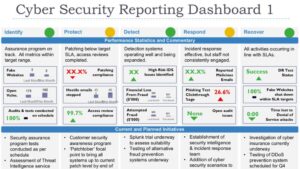In this era of digitalization, threats to cyberspace have become very sophisticated. Companies, institutions, and individuals alike confront these constant threats of cyberspace: the threats of data leaks, hacking, and malware assaults. Especially without a centralized monitoring system, tracking security vulnerabilities and threats can be overwhelming.
A cybersecurity dashboard is needed here. It serves as a centralized source that offers up-to-date analysis of possible weaknesses, security incidents, and general risk assessment. This post investigates the characteristics, advantages, and typical applications of a cybersecurity dashboard to assist you in understanding why it is a necessary tool for cybersecurity management.
What Is a Cybersecurity Dashboard?
The Cybersecurity Dashboard graphically shows a business’s security stance by means of real-time monitoring, analysis, and reporting on cyber threats, system vulnerabilities, or security events.
Therefore, systematically presenting data from several security tools in a user-friendly interface helps IT and security experts to make wise judgments based on all-source intelligence.
Key Functions of a Cybersecurity Dashboard:
- Real-time monitoring of security incidents
- Threat detection and alerts for suspicious activities
- Vulnerability assessment to identify weak spots
- Compliance tracking to meet industry regulations
- Incident response coordination for quick action
- Data visualization to track security performance over time
- Automated threat intelligence integration for proactive defense
Cybersecurity dashboards are key to improving situational awareness for response against cyber threats and not against the security team.
Features of a Cybersecurity Dashboard
Real-Time Threat Monitoring
A cybersecurity dashboard constantly searches the network for odd behavior and offers immediate warnings for possible security issues. This lets personnel rapidly notice and contain security issues before they worsen.
Customizable Reports & Analytics
Covering domains including compliance, risk levels, and security breaches, users can create reports customized to the needs of their company. More sophisticated dashboards even enable users to make tailored queries and set up automatic reporting schedules.
User Access Management
A good dashboard comes with role-based access control (RBAC) to guarantee that only approved staff have access to sensitive data. This solves inside threats and unauthorized access.
Vulnerability Scanning & Risk Assessment
Finds system flaws, out-of-date apps, and configuration errors that attackers might use. Some dashboards also offer automatic patch management advice to help protect your data.
Compliance Tracking & Audit Logs
Monitoring compliance measurements and keeping audit records helps businesses to stay in line with industry standards like GDPR, HIPAA, and ISO 27001. Automated compliance checks cut manual work and guarantee security policy compliance.
Integration with Security Tools
Brought together in one place, a cybersecurity dashboard coordinates with endpoint detection tools, antivirus software, SIEM systems, and firewalls to streamline security data. Further improving its threat detection abilities is the capacity to mesh AI-driven security analytics.
Incident Response Automation
Many sophisticated cybersecurity dashboards have automated incident response capabilities. Predefined systems are activated to respond to a security threat and help keep it under control, therefore reducing harm.
User Behavior Analytics (UBA)
Many present cybersecurity dashboards use UBA to identify unusual user activity, suggesting a security threat. This proactive capability stops insider assaults and credential abuse.
Threat Intelligence Integration
Other dashboards use threat intelligence channels to offer current data on developing internet risks. This proactive refinement of security controls helps security teams to get ahead of threats.
Advanced Machine Learning & AI Capabilities
Some cybersecurity panels use artificial intelligence-powered analysis to forecast and stop security incidents. Over time, these technologies learn from past events and increase detection sensitivity.
Benefits of Using a Cybersecurity Dashboard
Enhanced Visibility & Centralized Monitoring
A cybersecurity dashboard offers a bird’s-eye perspective of a company’s security posture, thus simplifying threat identification. Security teams don’t have to manually search several security logs anymore.
Improved Incident Response
Real-time alerts and automated response systems enable security teams to react more quickly, therefore reducing downtime and damage.
Better Decision-Making
Data-driven insights enable IT departments to best apportion resources and prioritize security risks. Dashboards within predictive analytics help security experts predict possible dangers before they actually happen.
Regulatory Compliance
Guarantee that companies comply with cybersecurity standards and escape large penalties. Some dashboards simplify audits by means of automated compliance analysis.
Reduced Security Costs
Early discovery of weaknesses helps companies avert expensive security incidents and data breaches. Further lowering manual labor on IT personnel is solved by automated remediation recommendations.
Boosted Productivity
Centralized monitoring and automatic threat responses free IT groups from manually handling security alerts to concentrate more on proactive defense tactics.
Improved Cyber Resilience
Due to early risk identification and prevention, companies operating cybersecurity dashboards are better prepared for phishing efforts, zero-day exploits, and ransomware assaults.
Enhanced Risk Management
Organizations can forecast and stop cyber attacks by constantly reviewing security metrics, thereby enhancing their general security posture.
Use Cases of Cybersecurity Dashboards
Enterprise Security Management
Big companies employ cybersecurity dashboards to oversee security events across many regions and departments. The dashboards help to simplify security operations, lower reaction times, and guarantee uniform security policies throughout the company.
Financial Institutions
To defend against fraud, phishing attempts, and ransomware, financial institutions and banks depend on these dashboards. Because financial data is sensitive, real-time monitoring is absolutely vital to spot transaction and user behavior anomalies.
Healthcare Organizations
To protect patient information and sustain HIPAA compliance, hospitals and medical institutions use cybersecurity dashboards. Dashboards offer an essential level of protection for electronic medical records in view of increasing cyberattacks on healthcare systems.
Government Agencies
Government agencies protect national security information and vital systems from cyber threats using cybersecurity panels. These dashboards assist in tracking cyber espionage operations and state-sponsored attacks.
Small & Medium Businesses (SMBs)
Small firms also profit from cybersecurity dashboards in terms of improved cyber resilience and customer data security. Small and medium businesses can use cloud-based security dashboards offering corporate security for a fraction of the price.
E-commerce & Retail Sector
E-commerce operations use cybersecurity panels to shield customer payment information, spot fraud, and stop data breaches in line with the explosion in internet transactions.
Educational Institutions
To protect research work, intellectual property, and student data from cyber threats, higher education institutions use cybersecurity dashboards.
Conclusion
A strong instrument for companies to effectively monitor, analyze, and react to security threats is a cybersecurity dashboard. These dashboards improve cybersecurity management and lower risks by means of compliance monitoring, vulnerability assessment, and real-time danger detection.
Having a well-implemented cybersecurity dashboard guarantees proactively defense strategies, improved compliance management, and a better security posture for companies of every size as online threats keep changing.

Ahsan Ali is a technology blogger and the founder of Techzivo.com, a platform dedicated to delivering insightful and practical content for tech enthusiasts.He currently focuses on creating in-depth articles around cybersecurity, aiming to help readers stay safe and informed in the digital world. With a passion for emerging technologies, Ahsan plans to expand Techzivo’s coverage into other technology micro-niches such as AI, cloud computing, and digital privacy, offering valuable insights for a broader tech-savvy audience.




